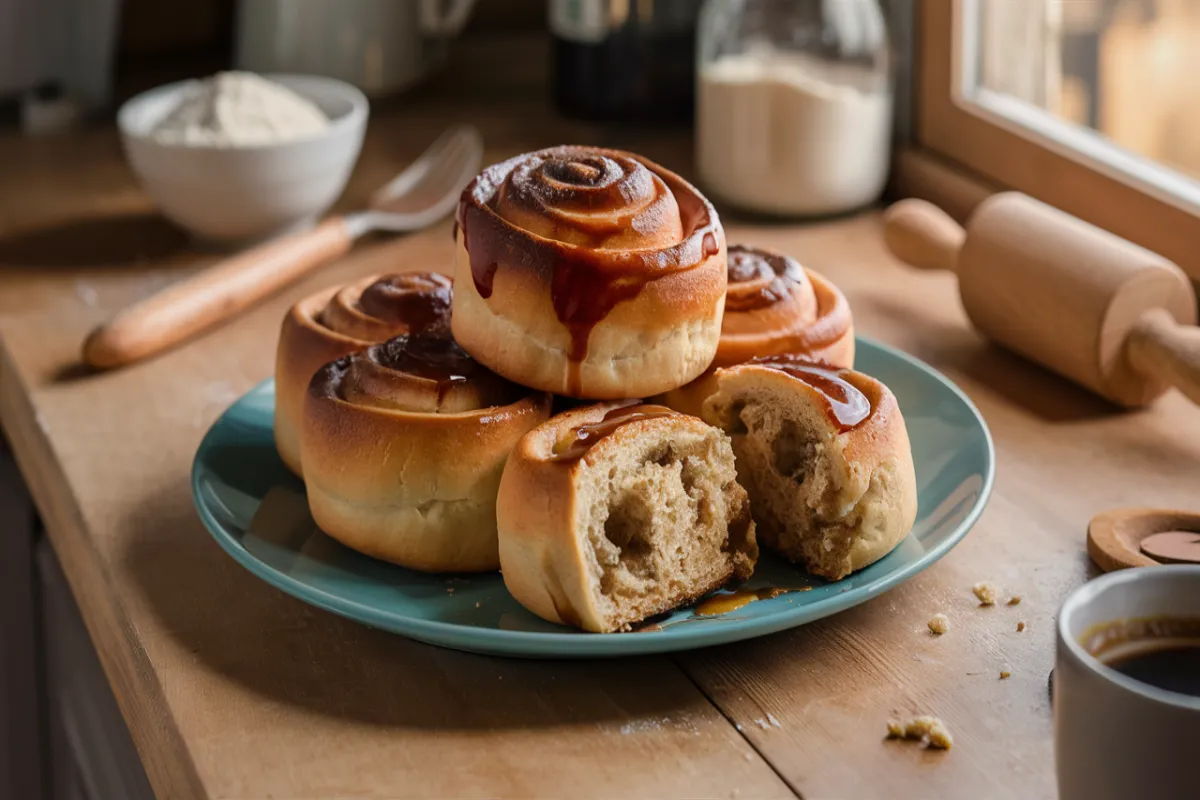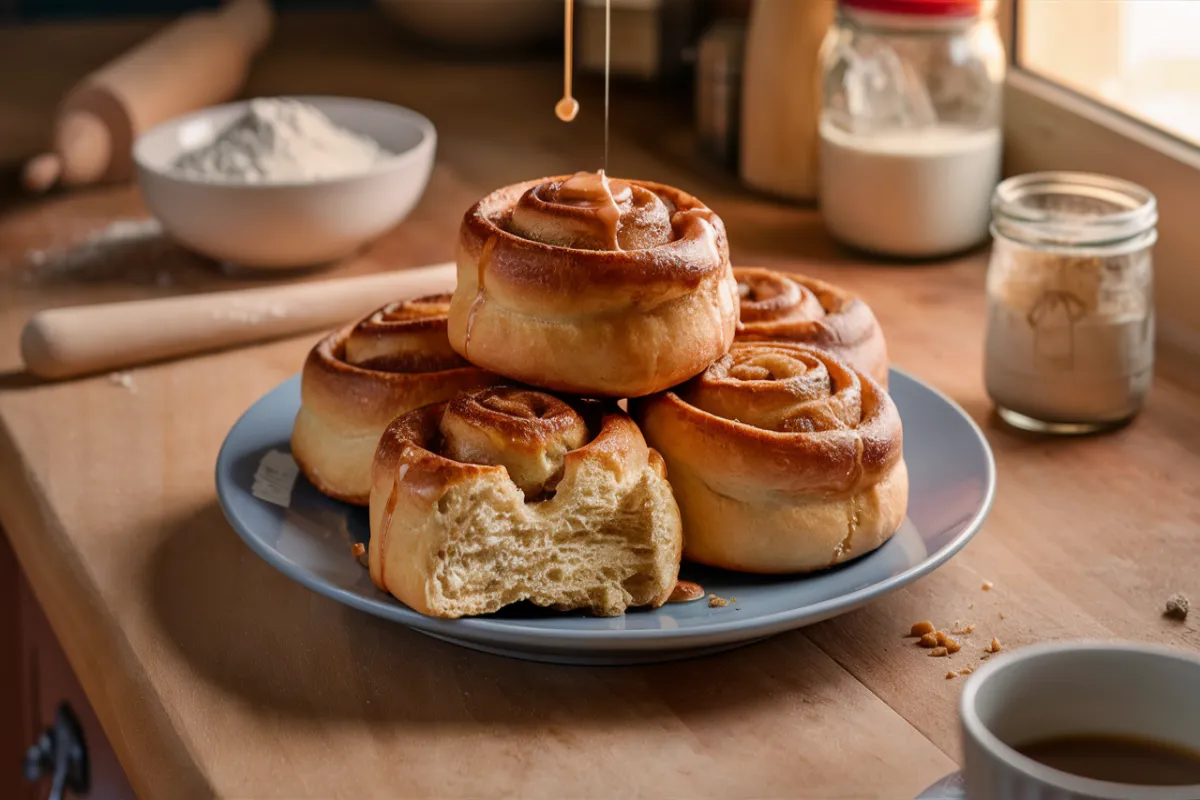Cinnamon rolls are a beloved indulgence for many. They combine soft, fluffy dough with a sweet, spiced filling. Often, they are topped with a luscious glaze. However, if you’re mindful of your carbohydrate intake, you might wonder, “How many carbs are in a sourdough cinnamon roll?”
In this article, we’ll explore how many carbs are in a sourdough cinnamon roll, compare it to traditional cinnamon rolls, and provide tips on managing your carb intake. You can still enjoy these delicious treats without overindulging in carbs.
What Are Carbohydrates?
Before we dive into specifics, it’s important to understand what carbohydrates are. Carbohydrates are one of the three macronutrients. They provide energy to the body, along with proteins and fats. Carbs are found in various foods, including grains, fruits, vegetables, dairy products, and sweets.
Carbohydrates come in three main types:
- Sugars: These are simple carbs, quickly absorbed by the body, providing immediate energy.
- Starches: These are complex carbs found in foods like bread, pasta, and potatoes. They break down into sugars during digestion.
- Fiber: This is a type of carbohydrate that the body cannot digest. It plays a crucial role in digestive health.
When you eat carbohydrates, your body converts them into glucose (sugar). This glucose is then used for energy. Monitoring your carbohydrate intake is important, especially if you’re managing diabetes or following a low-carb diet.
How Many Carbs Are in a Sourdough Cinnamon Roll?

How many carbs are in a sourdough cinnamon roll? The carbohydrate content in a sourdough cinnamon roll can vary depending on the recipe, ingredients, and portion size. On average, a standard homemade sourdough cinnamon roll contains about 40 to 60 grams of carbohydrates per roll. However, this number can change based on specific ingredients and preparation methods.
1. Flour and Its Impact on Carbs in Sourdough Cinnamon Rolls
Flour is the primary source of carbohydrates in a sourdough cinnamon roll. The type and amount of flour used can significantly impact the carb content. For example, all-purpose flour and bread flour contain about 90-95 grams of carbohydrates per cup. Whole wheat flour, while slightly lower in carbs, still contains about 80-85 grams per cup.
- Impact of Sourdough: The fermentation process in sourdough baking slightly reduces the carbohydrate content. This happens because some of the starches are broken down by the wild yeast and bacteria. However, this reduction is minimal. Most of the carbs from the flour remain intact in the final product.
2. Sugar Content and Its Effect on Carbs in Sourdough Cinnamon Rolls
The sugar in the dough and filling also contributes to the total carbohydrate content. Most cinnamon roll recipes, including sourdough variations, include granulated sugar, brown sugar, or both. One tablespoon of sugar adds about 12-15 grams of carbohydrates. If a recipe calls for half a cup of sugar in the dough and another half cup in the filling, this can add up to around 100 grams of carbs just from the sugar alone.
- Glaze or Frosting: If you add a glaze or frosting to your sourdough cinnamon rolls, this can further increase the carbohydrate content. A typical powdered sugar glaze can add an additional 20-30 grams of carbs per roll, depending on how much is used.
3. Additional Ingredients and Their Contribution to Carbs in Sourdough Cinnamon Rolls
Other ingredients, such as milk, butter, and eggs, contribute a smaller amount of carbohydrates. For example, a cup of whole milk contains about 12 grams of carbs, while an egg contains less than 1 gram. While these numbers are relatively low compared to flour and sugar, they still contribute to the overall carb content of the rolls.
Comparing Sourdough Cinnamon Rolls to Regular Cinnamon Rolls
When considering the carbohydrate content, it’s helpful to compare sourdough cinnamon rolls to their regular, yeast-based counterparts. Both types of rolls contain similar ingredients, but there are some differences worth noting.
1. Carb Content in Regular Cinnamon Rolls vs. Sourdough Cinnamon Rolls
Traditional cinnamon rolls made with commercial yeast typically contain between 50 and 70 grams of carbohydrates per roll. This is slightly higher than the average sourdough cinnamon roll. The primary reason for this difference is that sourdough fermentation can slightly reduce the starch content.
- Portion Size: Regular cinnamon rolls are often larger and more indulgent, leading to higher carb content. Store-bought or bakery cinnamon rolls, which are often oversized, can contain upwards of 80-100 grams of carbohydrates per roll, especially when generously frosted.
2. Nutrient Profile and Carbs in Sourdough Cinnamon Rolls
While the carbohydrate content of sourdough and regular cinnamon rolls is similar, sourdough rolls may offer a slight nutritional edge due to the fermentation process. Sourdough fermentation can increase the bioavailability of certain nutrients. This process makes them easier for the body to absorb. Additionally, sourdough has a lower glycemic index, meaning it may have a less significant impact on blood sugar levels compared to regular cinnamon rolls.
Managing Carbs in Sourdough Cinnamon Rolls

If you’re watching your carbohydrate intake but still want to enjoy sourdough cinnamon rolls, there are several strategies you can use to manage the carbs.
1. Portion Control to Reduce Carbs in Sourdough Cinnamon Rolls
One of the most effective ways to manage carbohydrate intake is to control your portion size. Instead of eating a whole roll, consider having half or even a quarter of a roll. This is especially helpful if the rolls are large. It allows you to enjoy the flavors without consuming as many carbs.
- Mini Cinnamon Rolls: Another option is to make smaller cinnamon rolls. By rolling the dough more thinly and cutting smaller pieces, you can create mini rolls that are lower in carbs per serving.
2. Reducing Sugar to Lower Carbs in Sourdough Cinnamon Rolls
You can reduce the carbohydrate content by cutting back on the sugar in the dough and filling. Try using half the amount of sugar the recipe calls for, or substitute some of the sugar with a low-carb sweetener like stevia or erythritol.
- Natural Sweeteners: Consider using natural sweeteners like honey or maple syrup. They may have a slightly lower glycemic index than white sugar. However, these are still high in carbohydrates, so use them sparingly.
3. Whole Grain Flours and Carbs in Sourdough Cinnamon Rolls
Replacing some or all of the all-purpose flour with whole grain flours like whole wheat or spelt can increase the fiber content. This can help slow the absorption of carbohydrates and stabilize blood sugar levels. Keep in mind that whole grain flours are still high in carbs, but they offer additional nutritional benefits like fiber, vitamins, and minerals.
- Almond Flour or Coconut Flour: For a lower-carb option, you can experiment with using almond flour or coconut flour. These flours are much lower in carbohydrates than traditional wheat flours. However, they require adjustments in the recipe, as they behave differently in baking.
4. Skipping the Glaze to Reduce Carbs in Sourdough Cinnamon Rolls
Skipping the glaze or frosting on your sourdough cinnamon rolls can significantly reduce the carbohydrate content. If you still want a touch of sweetness, try a light dusting of powdered sugar or a drizzle of melted dark chocolate. This can add flavor without as many carbs.
5. Balancing Carbs with Protein and Fiber
When enjoying sourdough cinnamon rolls, try to balance your meal with a source of protein and fiber. This can help slow the absorption of carbohydrates and prevent blood sugar spikes. For example, pair your cinnamon roll with a serving of Greek yogurt, some nuts, or a high-fiber fruit like berries.
- Meal Timing: Consider when you’re eating your cinnamon roll. Consuming carbs earlier in the day, when your metabolism is more active, may be better for managing blood sugar levels than eating them late at night.
Lower-Carb Sourdough Cinnamon Roll Recipes
For those who want to enjoy sourdough cinnamon rolls while keeping carb intake in check, there are several lower-carb recipe adaptations you can try.
1. Almond Flour Sourdough Cinnamon Rolls for Lower Carbs
Almond flour is a popular low-carb alternative to wheat flour. It can be used to make sourdough cinnamon rolls with significantly fewer carbohydrates. However, almond flour does not contain gluten, so you’ll need to use a combination of almond flour and a low-carb binding agent like psyllium husk. This will help achieve a dough that holds together.
- Recipe Adaptation: Replace the wheat flour with almond flour and psyllium husk. Reduce the sugar in the filling and use a sugar-free sweetener for the glaze. These rolls will be denser and have a different texture than traditional cinnamon rolls, but they’ll be much lower in carbs.
2. Coconut Flour Sourdough Cinnamon Rolls for Lower Carbs
Coconut flour is a popular low-carb alternative to traditional flours, but it has unique properties compared to wheat flour. It’s highly absorbent, so you’ll need to use it sparingly and adjust the liquid ingredients in your recipe to achieve the right consistency.
- Recipe Adaptation: Replace part of the wheat flour with coconut flour. Adjust the hydration by adding more eggs or liquid. Use a low-carb sweetener in the filling and skip the glaze or use a sugar-free alternative.
3. Keto-Friendly Sourdough Cinnamon Rolls to Minimize Carbs
For those following a strict ketogenic diet, creating a keto-friendly version of sourdough cinnamon rolls may be possible. You can do this by using a combination of low-carb flours, such as almond and coconut flour, and avoiding any added sugars.
- Recipe Adaptation: Combine almond flour, coconut flour, and psyllium husk to create a keto-friendly dough. Use a sugar-free sweetener in the filling and forgo the glaze or use a sugar-free glaze made from cream cheese and erythritol.
Nutritional Considerations Beyond Carbohydrates in Sourdough Cinnamon Rolls

While carbohydrates are an important consideration, it’s also essential to look at the overall nutritional profile of sourdough cinnamon rolls. Understanding the balance of macronutrients (carbs, proteins, and fats) and the role of micronutrients (vitamins and minerals) can help you make informed decisions about how these treats fit into your diet.
1. Protein Content in Sourdough Cinnamon Rolls
Sourdough cinnamon rolls typically contain a moderate amount of protein. This comes from the flour, eggs, and any added nuts or seeds. Protein is crucial for muscle repair, immune function, and overall health. Pairing your roll with a protein-rich food, such as a serving of yogurt or a handful of nuts, can help balance the macronutrient profile of your meal.
2. Fat Content in Sourdough Cinnamon Rolls
The fat content in sourdough cinnamon rolls comes primarily from butter, eggs, and any added nuts or seeds. While butter and other fats contribute to the rich flavor and tender texture of the rolls, they also increase the calorie density. Balancing the fat content with other foods in your diet can help maintain overall health.
- Healthy Fats: Consider using healthier fat options. For example, replace some of the butter with avocado oil or add nuts for a boost of omega-3 fatty acids.
3. Fiber Content and Its Role in Sourdough Cinnamon Rolls
Fiber is essential for digestive health. It can help regulate blood sugar levels by slowing the absorption of carbohydrates. Using whole grain flours or adding ingredients like flaxseed, chia seeds, or psyllium husk to your dough can increase the fiber content of your sourdough cinnamon rolls.
- Whole Grains: Incorporating whole wheat, spelt, or rye flour into your dough can boost the fiber content while still providing the structure needed for the rolls to rise.
Frequently Asked Questions (FAQs)
1. How Many Carbs Are in a Homemade Sourdough Cinnamon Roll?
A homemade sourdough cinnamon roll typically contains between 40 and 60 grams of carbohydrates per roll, depending on the recipe and portion size.
2. Can I Make Low-Carb Sourdough Cinnamon Rolls?
Yes, you can make lower-carb versions of sourdough cinnamon rolls by using alternative flours like almond or coconut flour, reducing the sugar content, and skipping the glaze.
3. How Does Sourdough Affect the Carb Content?
The fermentation process in sourdough slightly reduces the carbohydrate content by breaking down some of the starches. However, the reduction is minimal, and most of the carbs remain intact.
4. Is Sourdough Cinnamon Roll Healthier Than Regular Cinnamon Roll?
Sourdough cinnamon rolls may offer a slight nutritional edge due to the fermentation process, which can improve nutrient absorption and result in a lower glycemic index compared to regular cinnamon rolls.
5. What Is the Best Way to Reduce Carbs in Sourdough Cinnamon Rolls?
To reduce carbs, consider using alternative flours, reducing sugar, skipping the glaze, and practicing portion control.
Conclusion
Sourdough cinnamon rolls are a delicious treat, but like all baked goods, they contain a significant amount of carbohydrates. Understanding how many carbs are in a sourdough cinnamon roll can help you make informed choices about when and how to enjoy them as part of a balanced diet. Whether you’re following a low-carb diet, managing diabetes, or simply watching your carb intake, there are strategies you can use to enjoy sourdough cinnamon rolls while staying within your dietary goals.
From portion control to recipe modifications, there are numerous ways to reduce the carb content without sacrificing flavor. And while sourdough cinnamon rolls do contain carbs, they also offer the benefits of sourdough fermentation, which can enhance nutrient absorption and contribute to overall digestive health.
By being mindful of ingredients, portion sizes, and recipe adaptations, you can enjoy the occasional sourdough cinnamon roll as part of a healthy, balanced diet. Remember, balance and moderation are key to enjoying your favorite foods while maintaining your health.

